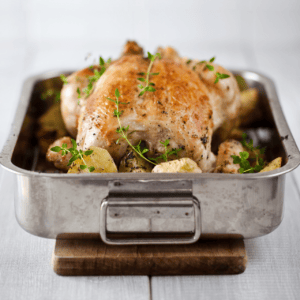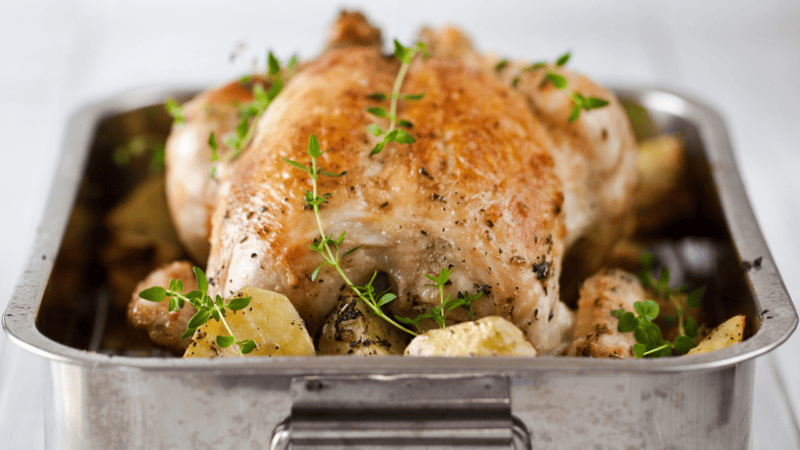Last Updated on January 27, 2025
Whether you’re new to the kitchen or a more experienced home chef, the idea of roasting a whole chicken can be daunting. That’s why we believe you’ll love this basic recipe for roasting our Pasture-Raised Heirloom Whole Chicken. These practical tips make it easy, ensuring your chicken is consistently delicious and perfectly cooked every time.
Adjust your cooking times!
It’s important to adjust roasting times when cooking a pasture-raised bird. Since there is more muscle, the meat cooks faster which means less time is needed in the oven. For the best result, roast the chicken at 400°F until golden brown and the internal temperature is 165°F in the thickest part of the thigh.
Wet vs. Dry Brine
Brining is a seasoning method that infuses meat with flavor and helps it to retain moisture during cooking. One of the easiest ways to use this technique is with a dry brine. Traditional brines require submerging a whole bird in a saltwater bath, but a dry brine adds flavor while simultaneously drying the skin, which will help it to crisp and darken during roasting. Plus, it’s much easier to maneuver.
To dry brine: generously salt the chicken, season under the skin of each breast and inside the cavity. Allow the chicken to rest uncovered for at least one hour or up to two days in the refrigerator. Ideally, the chicken will brine on a wire rack over a rimmed baking sheet for maximum air circulation, but a plate or bowl is fine, too.
Do I need Twine?
Trussing a chicken can be done in a few different ways. If you don’t have butcher’s twine, roasting the chicken with the legs splayed open is perfectly fine. If you do have some twine handy, it’s a great way to keep any aromatic stuffing inside the cavity while keeping the wings tucked behind the bird. After stuffing your chicken, wrap a long piece of twine around the “ankles” of your chicken and secure them loosely together. Tuck the wings behind the bird, then wrap the remaining twine around the wings, tying it just above the neck bone.
Roasting and Basting
Always point the legs of your chicken toward the back of the oven and the neck and breasts to the front. This will encourage the legs of the chicken to cook faster, as the back of the oven is hotter. Coat your roast chicken with extra-virgin olive oil before popping it in the oven. No need to baste!
20-Minute Power Nap
Resting a whole chicken after roasting allows time for the juices to redistribute, which ensures juicier meat. 10 to 20 minutes will do wonders for a whole roasted bird.
Feeding a crowd?
Roast two chickens at the same time for double the servings and double the chicken stock! When ready to roast, place both chickens in the center rack with adequate space between them. If the oven is too small to accommodate both chickens on the center rack, rotate the positions halfway through roasting to ensure an even cook.

Ingredients
For the chicken:
- 1 3-4 pound Pasture-Raised Heirloom Whole Chicken
- kosher salt
- freshly ground black pepper
- butcher’s twine optional
- extra-virgin olive oil
Optional aromatics:
- quartered onions
- garlic cloves peeled
- woody herbs rosemary, thyme, sage, or oregano
- lemon(s) halved
Instructions
- Season the chicken generously with salt and pepper, including under the skin and inside the cavity. Set the chicken aside for at least one hour at room temperature. If time allows, rest the chicken on a wire rack placed inside of a rimmed baking sheet in the refrigerator, uncovered, overnight or up to two days.
- Adjust the oven rack to the center position. Preheat the oven to 400°F and place an oven-safe (preferably cast iron) skillet on the rack. Stuff the cavity of the bird with any aromatics you may have on hand. If not, no sweat! It will still be a great chicken.
- If any moisture is present on the surface of the chicken, pat it dry with a paper towel or clean cloth. If trussing, cut a long piece of butcher’s twine. Tie the legs loosely together with twine, tuck the ends of the wings behind the bird, and secure with the remaining twine around the neck to hold the wings in place.
- Brush or rub the chicken skin liberally with olive oil. Remove the preheated cast-iron skillet from the oven and place the chicken in the pan. Return the pan to the oven with the legs facing the back. Roast until the skin is golden brown and an instant-read thermometer reaches 165°F when inserted into the thickest part of the thigh, 40 minutes to one hour.
- Transfer the chicken to a cutting board and rest for 15 minutes.
- Remove the butcher’s twine and break down the chicken, beginning with removing the legs, then cutting the breasts away from the carcass, don’t forget the oysters at the back of the chicken where the thigh meets the spine!
Ashley Lonsdale is the chef at ButcherBox. Her big hope is for a world where everyone can access the joy of food. That hope is precisely why she spends her free time as an associate board member for the Food Education Fund and writing recipes for her newsletter FOODSTAR. Previously, she was the culinary director for Daily Harvest, a private chef, and a line cook in various New York City kitchens. She is a graduate of the French Culinary Institute.



